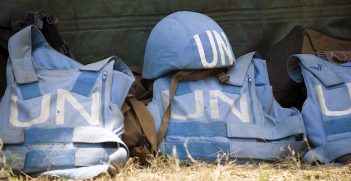Reading Room: The Oxford Handbook of the Responsibility to Protect

In 53 chapters and more than 1,000 pages, this substantial work of scholarship charts the rapid philosophical and theoretical development of the R2P doctrine—and its only marginal impact operationally to date.
The Oxford Handbook of the Responsibility to Protect (R2P) is a substantial work of scholarship. The editors have gathered together 53 articles that cover most aspects of this nascent political doctrine, across the spectrum from theory to practice. The collection will be of significant interest to politicians, diplomats, civil society actors and academics practising in the spheres of international law and international relations. At more than 1,000 pages, it is likely to become the initial comprehensive reference for anyone interested in a serious study of the prevention of mass atrocity crimes.
The R2P doctrine holds that the primary responsibility for protecting against the commission of the crimes of genocide, crimes against humanity, war crimes or ethnic cleansing rests with the sovereign government of the country in which there is a risk that such crimes may occur. Where, however, a sovereign government has manifestly failed in its responsibility, the international community assumes a complementary duty to take collective action through the UN and regional organisations to protect populations at risk of death, grievous injury or other serious harm.
R2P has been on the international agenda since it was endorsed unanimously by the leaders at the United Nations’ 2005 World Summit. There is substantial support amongst UN member states for its moral and ethical mission. In that context, its philosophical and theoretical development has been sophisticated and rapid. The heart of the matter does not lie there, however.
The problem is that the doctrine has, as yet, had only a marginal impact operationally: that is, in actually preventing crimes that shock the conscience. The commission of egregious crimes continues unabated across many countries and continents. It is far easier to count the numerous instances since 2005 in which R2P has failed to have an impact than those where successful implementation has occurred.
Authors in this volume have dealt purposefully but not always successfully with this dilemma. For example it is difficult to argue, as some writers do, that R2P represents a paradigm shift in the conduct of international relations. That argument may make some headway at the level of theory, but there is just too much contradictory evidence on the ground to justify the claim.
Amongst the countries ravaged by conflict and crime, it might reasonably be said that R2P was influential in framing and influencing protection against mass atrocity crimes in two: Kenya after the election in 2008 and Cote D’Ivoire in 2011. As against that, these crimes have continued to be committed, for years, in Libya, Syria, Yemen, the Democratic Republic of the Congo, Darfur, South Sudan, the Central African Republic, North Korea, Sri Lanka and, most recently, Myanmar. The implementation record is not edifying.
Other authors claim success for the doctrine by citing the number of times to which it has been referred in the resolutions of the Security Council, the General Assembly and the Human Rights Council. There have been more than 50 such references since the doctrine’s advent. It is not unimportant to note that R2P has filtered into the deliberations of these influential inter-governmental forums. But until such preambular references turn somehow into positive preventative actions, particularly by the Security Council, R2P’s contribution to international peace and security will remain modest.
A careful study of specific country situations and the dynamics of the international community’s interventions there, whether successful or otherwise, is likely to provide the most cogent guide to the means and methods of R2P’s more effective implementation. The handbook provides 14 impressive case studies from which much can be learnt.
So, while there remains a pretty strong case for despondency about R2P, nevertheless the handbook contains several chapters that look creatively and constructively to the future. Jennifer Welsh, for example, maps out the doctrine’s prospects by exploring its potential to strengthen the international community’s commitment to respond assertively to mass atrocity crime and to create new and enduring rules and institutions for strengthening protection of civilians.
Lloyd Axworthy sees R2P’s primary contribution as challenging the traditional concept of sovereignty. Within a human security framework, the solution to international criminality can no longer be considered as residing exclusively within the province of nation states. In mediating sovereign authority, R2P has the potential to contribute to the development of a humanity-based framework of rules for addressing global risks.
Fellow of the AIIA Gareth Evans provides a majestic overview of R2P’s progression. Admirably, he does not shy away from tackling the doctrine’s most formidable problems. He is critical, for example, of those in the “academic industry” and elsewhere who shrink from the use of coercive military action as the last resort to stop the commission of mass atrocity crime. Yes, interveners may have mixed motives; intervention may be selective; it is inevitable that reversals will occur after militaries depart; and the balance of consequences will always be difficult to assess. To such objections Evans replies characteristically, “Welcome to the real world”.
If R2P is to make any serious headway in its second decade, in grievous cases the Security Council will need to take forceful, coercive action to protect against genocide and crimes against humanity. Excuses and rationalisations don’t save lives.
Alex J. Bellamy and Tim Dunne (eds.), The Oxford Handbook of the Responsibility to Protect, Oxford University Press, Oxford, 2016.
Professor Spencer Zifcak is Professor of Law at Australian Catholic University. He was for 10 years a vice-president of the International Commission of Jurists (Australian Section). His most recent book is ‘Rethinking International Law and Justice’ with Charles Sampford.





